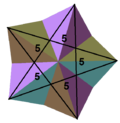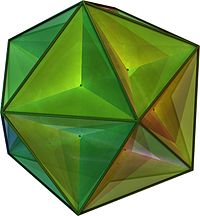Great dodecahedron
| Great dodecahedron | |
|---|---|

| |
| Type | Kepler–Poinsot polyhedron |
| Stellation core | regular dodecahedron |
| Elements | F = 12, E = 30 V = 12 (χ = -6) |
| Faces by sides | 12{5} |
| Schläfli symbol | {5,5⁄2} |
| Face configuration | V(5⁄2)5 |
| Wythoff symbol | 5⁄2 | 2 5 |
| Coxeter diagram | |
| Symmetry group | Ih, H3, [5,3], (*532) |
| References | U35, C44, W21 |
| Properties | Regular nonconvex |
 (55)/2 (Vertex figure) |
 Small stellated dodecahedron (dual polyhedron) |
In geometry, the great dodecahedron is a Kepler-Poinsot solid. It is one of four nonconvex regular polyhedra. It is composed of 12 pentagonal faces, with five pentagons meeting at each vertex, intersecting each other making a pentagrammic path.
The 12 vertices and 30 edges are shared with the icosahedron.
This shape was the basis for the Rubik's Cube-like Alexander's Star puzzle.
Shaving off the concave part results in a dodecahedron.
It is considered the second of three stellations of the dodecahedron.
If the great dodecahedron is considered as a properly intersected surface geometry, it has the same topology as a triakis icosahedron with concave pyramids rather than convex ones.

Transparent great dodecahedron (Animation)
As a stellation
It can also be constructed as the second of four stellations of the dodecahedron, and referenced as Wenninger model [W21].
The stellation facets for construction are:

